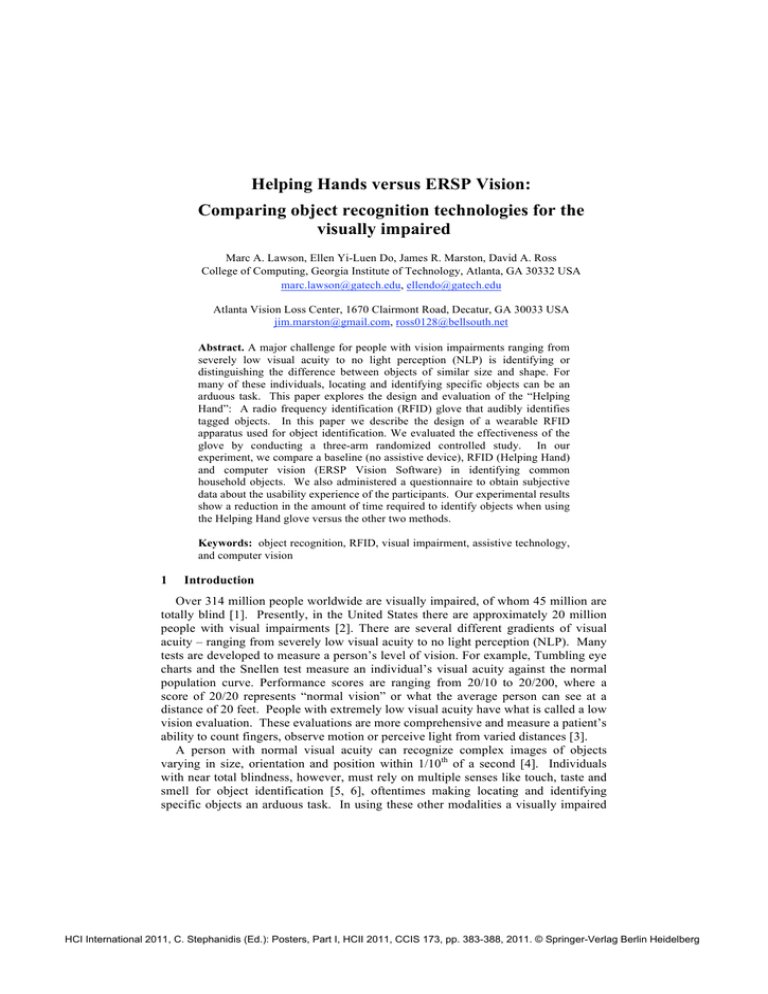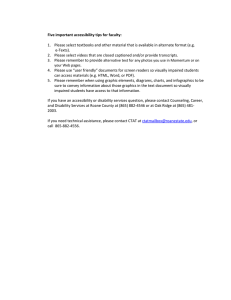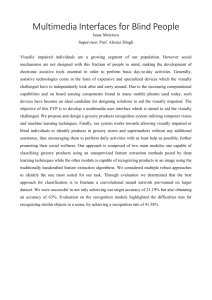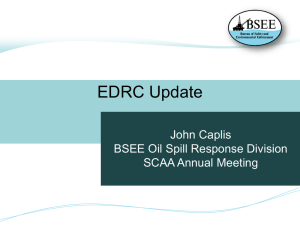Helping Hands versus ERSP Vision: Comparing object recognition technologies for the
advertisement

Helping Hands versus ERSP Vision: Comparing object recognition technologies for the visually impaired Marc A. Lawson, Ellen Yi-Luen Do, James R. Marston, David A. Ross College of Computing, Georgia Institute of Technology, Atlanta, GA 30332 USA marc.lawson@gatech.edu, ellendo@gatech.edu Atlanta Vision Loss Center, 1670 Clairmont Road, Decatur, GA 30033 USA jim.marston@gmail.com, ross0128@bellsouth.net Abstract. A major challenge for people with vision impairments ranging from severely low visual acuity to no light perception (NLP) is identifying or distinguishing the difference between objects of similar size and shape. For many of these individuals, locating and identifying specific objects can be an arduous task. This paper explores the design and evaluation of the “Helping Hand”: A radio frequency identification (RFID) glove that audibly identifies tagged objects. In this paper we describe the design of a wearable RFID apparatus used for object identification. We evaluated the effectiveness of the glove by conducting a three-arm randomized controlled study. In our experiment, we compare a baseline (no assistive device), RFID (Helping Hand) and computer vision (ERSP Vision Software) in identifying common household objects. We also administered a questionnaire to obtain subjective data about the usability experience of the participants. Our experimental results show a reduction in the amount of time required to identify objects when using the Helping Hand glove versus the other two methods. Keywords: object recognition, RFID, visual impairment, assistive technology, and computer vision 1 Introduction Over 314 million people worldwide are visually impaired, of whom 45 million are totally blind [1]. Presently, in the United States there are approximately 20 million people with visual impairments [2]. There are several different gradients of visual acuity – ranging from severely low visual acuity to no light perception (NLP). Many tests are developed to measure a person’s level of vision. For example, Tumbling eye charts and the Snellen test measure an individual’s visual acuity against the normal population curve. Performance scores are ranging from 20/10 to 20/200, where a score of 20/20 represents “normal vision” or what the average person can see at a distance of 20 feet. People with extremely low visual acuity have what is called a low vision evaluation. These evaluations are more comprehensive and measure a patient’s ability to count fingers, observe motion or perceive light from varied distances [3]. A person with normal visual acuity can recognize complex images of objects varying in size, orientation and position within 1/10th of a second [4]. Individuals with near total blindness, however, must rely on multiple senses like touch, taste and smell for object identification [5, 6], oftentimes making locating and identifying specific objects an arduous task. In using these other modalities a visually impaired HCI International 2011, C. Stephanidis (Ed.): Posters, Part I, HCII 2011, CCIS 173, pp. 383-388, 2011. © Springer-Verlag Berlin Heidelberg person can sometimes spend a significant amount of their time trying to identify common everyday objects. The question is then, what tools can we offer to help reduce the time needed for such tasks? Object recognition technology can be used to improve the visual perception process for the visually impaired by providing audible feedback describing objects. Our research evaluates the effectiveness of a wearable RFID design we have developed versus other established object identification methods. 2 Helping Hand System Overview This section describes the components of the Helping Hand. The system is comprised of 3 different modules: a RFID Antenna, a Microcontroller board and a Secure Digital (SD) sound shield. Below we describe each module separately. 2.1 Main Board The microcontroller board used in our prototype is the Arduino Duemilanove. The system software controlling the microcontroller was developed in Wiring and is programmed to recognize a number of passive transponder tags detected by an attached RFID antenna. When an incoming message ID is received it is validated and then associated with a wave file stored on an internal SD sound card. An audible wave file is then played as feedback. The board and battery are stored in a glove pocket positioned on the back of the wrist and lower forearm region. The mounting location for the components was selected for freedom of movement in the hand. 2.2 RFID Reader The RFID reader module is a Parallax low frequency serial reader. It interfaces with our microcontroller board and sends serial data at a rate of 2400 bits per second. It can detect a HF passive tag within a distance of 2 – 3 inches from the antenna. In our design, the reading antenna is positioned on the back of the palm. This gives the antenna the best possible angle of detection and does not occlude the use of the hand. 2.3 Sound Shield The sound shield provides audible feedback for our system. It connects to the main board and has a slot for a SD/MMC card. It plays 16 bit wave files stored on the SD card plugged into it. The audio files are preprogrammed and associated with transponder tags. When the reader identifies a tag, the associated sound identifying the object is played. The sound module possess a jack for headphones 3 Methods and Results To evaluate the effectiveness of our device versus other object recognition technologies, we conducted a within-subjects test design. Our goal was to capture performance variables for an objective comparison. In addition, we administered a questionnaire to obtain subjective data from each participant. 3.1 Subjects & Experimental Setup HCI International 2011, C. Stephanidis (Ed.): Posters, Part I, HCII 2011, CCIS 173, pp. 383-388, 2011. © Springer-Verlag Berlin Heidelberg In our study we tested 7 visually impaired participants consisting of 4 women and 3 men. We performed our participant testing at the Center for the Visually Impaired Georgia (CVIGA). Written informed consent was obtained from all subjects prior to testing. In addition, the participants provided information regarding their visual condition. Five of the participants were congenitally blind and had no light perception. The other two subjects, #4 and #7 were visually impaired due to the progressive diseases of Vogt-Koyanagi-Harada (VKH) syndrome & myopic degeneration respectively. These two subjects had been previously sighted. Subject #4 was totally blind and had light perception, while subject #7 was legally blind but could distinguish light, shape and color. The subjects were seated at a table throughout the entire experiment. Each participant was instructed on how to use both the Helping Hand and ERSP vision tools prior to being tested. Ten practice minutes were allotted for each tool. At the conclusion of the practice activity, a randomly selected object was placed in front of the subject on the table. Next, the participant was instructed on the identification method to be used and was asked to identify the object in front of them using that method. Each object identification method was tested 4 times. The objects were randomly selected to reduce any learned effects. 3.2 Objects The objects in the study were arranged into four groups. Each group is consisted of common household items of similar size and shape. One group includes different flavors of soda packaged in identical bottles. The other groups of items were comprised of medication bottles, cereal boxes and non-toxic cleaning agents. The items in each group were similar; however the groups were of different categories. A subject could easily distinguish a box of cereal from a bottle of soda. Items were added to each group to randomize the number of possible objects and to reduce the possibility that participants can easily predict what the object is being tested. 3.3 Measures We used two approaches to measure objective and subjective information in our testing. To obtain our objective data, a stopwatch was used to measure the amount of time required to correctly identify the objects. Object recognition times were recorded using 2 decimal point precision. For our subjective information we utilized a Likert survey which was verbally administered at the conclusion of each testing arm. The survey was comprised of four opinion questions scored on a seven-point scale from 1 (strongly disagree) to 7 (strongly agree). The questionnaire asked the participants to rank different aspects of the testing method based on the following four criteria: simplicity, practicality, predictability and preference 3.4 Results We measured the object recognition times for 7 visually impaired subjects using 3 different testing methods. The bar graph in figure 1 displays the percentage of improvement when using either Helping Hand or ERSP over the baseline (no device). In 6 of the 7 participants tested, the use of a technology, either with Helping Hand (RFID) or ERSP (computer vision), improved recognition times. HCI International 2011, C. Stephanidis (Ed.): Posters, Part I, HCII 2011, CCIS 173, pp. 383-388, 2011. © Springer-Verlag Berlin Heidelberg Figure 1. Percentage of improvement for each participant using Helping Hand or ERSP over the baseline (no device) For 5 participants, the Helping Hand prototype yielded the highest percentage of improvement. In one case (subject #7), the baseline (with no technology) was significantly faster than using either Helping Hand or the ERSP. Two factors could have contributed to this result. First, the data collected for subject #7 was averaged over 3 trials instead of 4. During one testing run, the camera used by the ERSP software malfunctioned resulting in an object recognition time delay of several minutes. This issue introduced a major outlier in our data set and was subsequently removed for others. An additional contributing factor could be the fact that even though subject #7 was legally blind, she was not totally blind. This subject’s ability to perceive light, shape and form may have contributed to the significantly faster baseline times, as she could distinguish the objects without using any device. Figure 2. Participants’ subjective evaluation for ease of use scores in 7-point scale for Q1, simple to use, Q2, practical, Q3, predictable, and Q4 preferred. Figure 2 shows the mean values for all the Likert survey scores. An analysis revealed the Helping Hand as the most simple to use (avg. 5.71, σ=1.25), practical HCI International 2011, C. Stephanidis (Ed.): Posters, Part I, HCII 2011, CCIS 173, pp. 383-388, 2011. © Springer-Verlag Berlin Heidelberg (avg. 5.57, σ=1.13), predictable (avg. 6.00, σ=1.41) and preferred (avg. 4.57, σ=1.62) of all the tested methods. In comparison, the scores for the ERSP device are significantly lower than the baseline, resulting in simplicity (avg. 3.71, σ=1.80), practicality (avg. 2.86, σ=2.04), predictability (4.86 avg. σ=2.04) and preference (avg. 3.14, σ=2.19) 4 Discussion To understand the effectiveness of our Helping Hand design, we evaluated our device against the baseline (no assistive device) and ERSP (computer vision). Our objective results revealed that the use of the Helping Hand produces faster object recognition times among the three methods studied. The results of our survey also showed positive participant opinion about the device. These are encouraging results. Meanwhile, the study revealed interesting results regarding partially sighted individuals using object recognition tools. Subject #7, a legally blind participant (who can distinguish light, shape and color) performed better when not using any assistive devices. This result leads to an interesting research question: Is there a low vision threshold for using object recognition devices? In this study we show that the Helping Hand performs better when evaluated against a baseline and the ERSP method, but our participant pool was rather small. To conclude that the device truly outperforms others we would need to conduct study with a larger population or to include at least twenty participants. Finally, future evaluations should compare the Helping Hand with a non-wearable RFID technology, to determine if the wearable design is the reason for the better performance. 5 Acknowledgements This material is based upon work supported by the Veterans Administration (VA), Atlanta Vision Loss Center (AVLC) and the Health Systems Institute (HIS) Seed Grant at Georgia Institute of Technology. Any opinions, findings, and conclusions or recommendations expressed in this material are those of the authors and do not necessarily reflect the views of the sponsoring organizations. We thank the Center for the Visually Impaired Georgia (CVIGA) for help in recruiting test subjects and providing a facility for us to run the comparative study. 6 References 1. “Visual impairment and blindness.” World Health Organization. May 2009 <http://www.who.int/mediacentre/factsheets/fs282/en/> 2. “Vision loss” United States Department of Veterans Affairs. May 2009 <http://www.research.va.gov/resources/pubs/docs/Vision-Loss.pdf> 3. Wendy Strouse Watt, O.D. “How Visual Acuity is measured” October 2003 [Online]. www.mdsupport.org/library/acuity.html [Accessed: 8/1/2010] 4. Irving Bierdman. “Visual Object Recognition.” An Invitation to Cognitive Science Cambridge: MIT Press, 1995. 5. Lacey, Simon, Andrew Peters, and K. Sathian “Cross-Modal Object Recognition is Viewpoint-Independent” PMC 2(9) 2007 6. Sensation and perception By E. Bruce Goldstein pg. 340 8th Edition Wadsworth HCI International 2011, C. Stephanidis (Ed.): Posters, Part I, HCII 2011, CCIS 173, pp. 383-388, 2011. © Springer-Verlag Berlin Heidelberg





